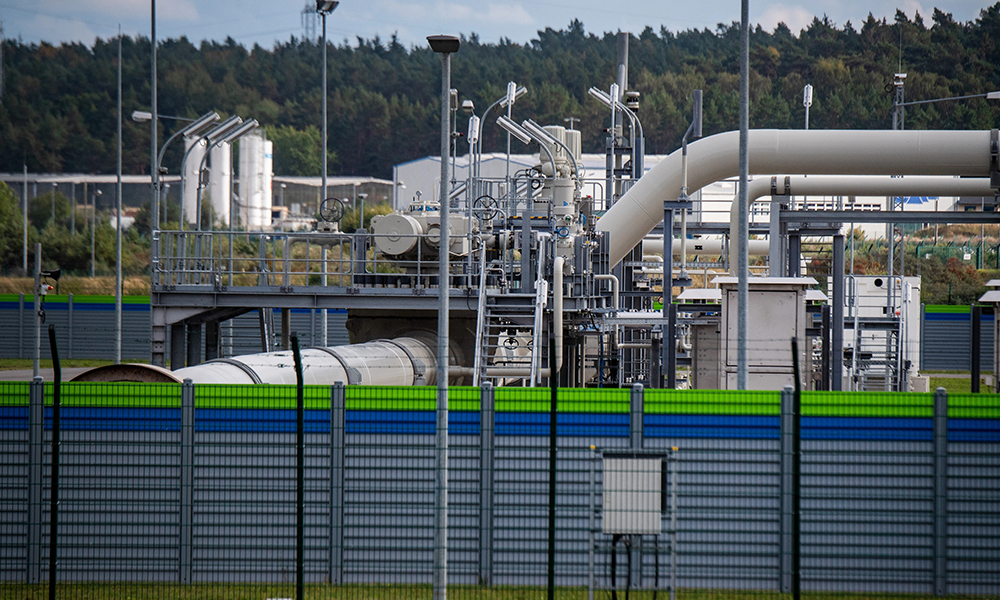
严冬之中,家庭取暖和商业用电的成本显著增长,数百万欧美人士因此哀叹不已,但他们应该为明年冬天更糟糕的情况做好准备。
经合组织(Organization of Economic Cooperation and Development)的首席经济学家阿尔瓦罗·桑托斯·佩雷拉说:“在欧洲,如果今年出现寒冬,情况就会变得复杂。但我们更担心明年。特别是在天然气市场,因为代替俄罗斯天然气将成为一项挑战。”
佩雷拉曾经担任葡萄牙的经济部部长。11月21日,他在法国巴黎对英美新闻协会(Anglo-American Press Association)的一小批记者做出上述表态。次日,总部设在巴黎的经合组织发布了它最重要的世界经济展望(World Economic Outlook)报告。该组织追踪约48个国家的数据,并估算全球几个最大经济体的增长率。这份报告考察了各个国家每年的表现,并对随后两年的前景做出了预测。
今年的预期令人警醒。佩雷拉表示,2022年全球经济将增长3.1%左右。考虑到2月24日俄乌冲突爆发以来波及整个世界的严重能源危机以及此前俄罗斯一直是全球主要能源供应国,这样的预期显得较为乐观。
但佩雷拉指出,到2023年才能看清全球经济面临的问题到底有多大。经合组织预测2023年全球经济增速将“大幅下降”至2.2%,“2024年稍稍反弹”至2.7%左右。
对美国来说,经合组织的预测甚至更糟。
明年美国经济增速仅为0.5%
经合组织预测,今年美国经济将增长1.8%,而明年增速仅为0.5%,2024年略有回升,达到1%。美国的能源出口量大于进口量,其中包括向欧洲出口的液化天然气,美国的目的是取代一部分俄罗斯能源,而这在一定程度上屏蔽了持续九个月的俄乌冲突带来的经济冲击。尽管如此,美国人仍然面临着高通胀和不断走弱的房地产市场,企业也仍然面对着供给紧张的劳动力市场和持续上升的薪资。经合组织的报告称:“和新冠疫情前相比,国内食品和汽油价格仍然居高不下,这主要是俄乌冲突所致。”
佩雷拉表示,最受伤的也许是俄罗斯自己,因为俄罗斯将出现“重大衰退,不仅是今年,明年和后年同样如此。很难想象我们怎样才能回到俄乌冲突之前的那个世界,或者那个能源世界。”
但预测的作用仅此而已。2021年12月,经合组织在225页的展望报告中对乌克兰只字未提。过了不到两个月,俄罗斯对乌克兰的特别军事行动就撼动了全球经济。
现在,全球各个经济体都受到了俄乌冲突的影响。佩雷拉称,这是自20世纪70年代以来最严重的能源危机。但冬季降临后,这场危机对欧洲的影响一直未能全面展现,部分原因是10月和11月的气温异常偏高,以及欧盟(European Union)27国中某些国家的政府选择对冬季家用能源限价。在一些国家,天然气批发价目前已经高于零售价。部分欧盟国家还停止向巴基斯坦等国出口天然气,转而选择充实自己的储气设施。在欧盟的某些地区,储气设施充盈率已经达到95%左右。
欧洲仍然需要俄罗斯天然气
但佩雷拉警告,到明年夏天,欧洲将面临一系列问题。
届时,欧洲储备的天然气或已耗尽,而俄罗斯天然气将不再向欧洲输送。到目前为止,俄罗斯天然气船仍然在驶往欧洲港口,但为了报复西方对俄罗斯总统弗拉基米尔·普京的制裁,俄罗斯已经切断了管道天然气供应。
对乌克兰采取特别军事行动前,欧洲十分依赖俄罗斯的能源供应,约有40%的天然气来自俄罗斯。虽然群情激奋,但欧洲不愿意制裁俄罗斯天然气,对欧天然气供应的急剧减少都是普京的选择,而非欧洲。
法国的能源专家蒂埃里·布罗斯在英美新闻协会于本月早些时候召开的简报会上表示:“我们没有禁运俄罗斯天然气,因为我们不能这样做。”他说欧洲天然气消费量中来自俄罗斯的“最低”要占约7%。
至少到目前为止,中国的经济滑坡和新冠疫情防控对欧洲还有帮助,原因是这让中国的能源消费量远低于新冠疫情前的水平。佩雷拉说:“欧洲不必和中国争夺天然气。”但按照经合组织的报告,明年亚洲将为全球经济增长做出最大贡献,届时情况可能会出现改变。佩雷拉指出:“中国经济复苏就意味着液化天然气(LNG)需求增多。那么中国要从哪里获得液化天然气呢?明年将会出现挑战。”(财富中文网)
译者:Charlie
严冬之中,家庭取暖和商业用电的成本显著增长,数百万欧美人士因此哀叹不已,但他们应该为明年冬天更糟糕的情况做好准备。
经合组织(Organization of Economic Cooperation and Development)的首席经济学家阿尔瓦罗·桑托斯·佩雷拉说:“在欧洲,如果今年出现寒冬,情况就会变得复杂。但我们更担心明年。特别是在天然气市场,因为代替俄罗斯天然气将成为一项挑战。”
佩雷拉曾经担任葡萄牙的经济部部长。11月21日,他在法国巴黎对英美新闻协会(Anglo-American Press Association)的一小批记者做出上述表态。次日,总部设在巴黎的经合组织发布了它最重要的世界经济展望(World Economic Outlook)报告。该组织追踪约48个国家的数据,并估算全球几个最大经济体的增长率。这份报告考察了各个国家每年的表现,并对随后两年的前景做出了预测。
今年的预期令人警醒。佩雷拉表示,2022年全球经济将增长3.1%左右。考虑到2月24日俄乌冲突爆发以来波及整个世界的严重能源危机以及此前俄罗斯一直是全球主要能源供应国,这样的预期显得较为乐观。
但佩雷拉指出,到2023年才能看清全球经济面临的问题到底有多大。经合组织预测2023年全球经济增速将“大幅下降”至2.2%,“2024年稍稍反弹”至2.7%左右。
对美国来说,经合组织的预测甚至更糟。
明年美国经济增速仅为0.5%
经合组织预测,今年美国经济将增长1.8%,而明年增速仅为0.5%,2024年略有回升,达到1%。美国的能源出口量大于进口量,其中包括向欧洲出口的液化天然气,美国的目的是取代一部分俄罗斯能源,而这在一定程度上屏蔽了持续九个月的俄乌冲突带来的经济冲击。尽管如此,美国人仍然面临着高通胀和不断走弱的房地产市场,企业也仍然面对着供给紧张的劳动力市场和持续上升的薪资。经合组织的报告称:“和新冠疫情前相比,国内食品和汽油价格仍然居高不下,这主要是俄乌冲突所致。”
佩雷拉表示,最受伤的也许是俄罗斯自己,因为俄罗斯将出现“重大衰退,不仅是今年,明年和后年同样如此。很难想象我们怎样才能回到俄乌冲突之前的那个世界,或者那个能源世界。”
但预测的作用仅此而已。2021年12月,经合组织在225页的展望报告中对乌克兰只字未提。过了不到两个月,俄罗斯对乌克兰的特别军事行动就撼动了全球经济。
现在,全球各个经济体都受到了俄乌冲突的影响。佩雷拉称,这是自20世纪70年代以来最严重的能源危机。但冬季降临后,这场危机对欧洲的影响一直未能全面展现,部分原因是10月和11月的气温异常偏高,以及欧盟(European Union)27国中某些国家的政府选择对冬季家用能源限价。在一些国家,天然气批发价目前已经高于零售价。部分欧盟国家还停止向巴基斯坦等国出口天然气,转而选择充实自己的储气设施。在欧盟的某些地区,储气设施充盈率已经达到95%左右。
欧洲仍然需要俄罗斯天然气
但佩雷拉警告,到明年夏天,欧洲将面临一系列问题。
届时,欧洲储备的天然气或已耗尽,而俄罗斯天然气将不再向欧洲输送。到目前为止,俄罗斯天然气船仍然在驶往欧洲港口,但为了报复西方对俄罗斯总统弗拉基米尔·普京的制裁,俄罗斯已经切断了管道天然气供应。
对乌克兰采取特别军事行动前,欧洲十分依赖俄罗斯的能源供应,约有40%的天然气来自俄罗斯。虽然群情激奋,但欧洲不愿意制裁俄罗斯天然气,对欧天然气供应的急剧减少都是普京的选择,而非欧洲。
法国的能源专家蒂埃里·布罗斯在英美新闻协会于本月早些时候召开的简报会上表示:“我们没有禁运俄罗斯天然气,因为我们不能这样做。”他说欧洲天然气消费量中来自俄罗斯的“最低”要占约7%。
至少到目前为止,中国的经济滑坡和新冠疫情防控对欧洲还有帮助,原因是这让中国的能源消费量远低于新冠疫情前的水平。佩雷拉说:“欧洲不必和中国争夺天然气。”但按照经合组织的报告,明年亚洲将为全球经济增长做出最大贡献,届时情况可能会出现改变。佩雷拉指出:“中国经济复苏就意味着液化天然气(LNG)需求增多。那么中国要从哪里获得液化天然气呢?明年将会出现挑战。”(财富中文网)
译者:Charlie
With millions of Americans and Europeans bemoaning the huge rise in cost to heat their homes and power their businesses during the bitter cold months, they ought to brace themselves for even worse times ahead—next winter.
“In Europe, if it is a cold winter this year, it will be complicated. But we are more concerned about next year,” says Álvaro Santos Pereira, chief economist for the Organization of Economic Cooperation and Development. “Especially in the gas markets, replacing the Russian gas is going to be a challenge.”
Pereira, a former economy minister of Portugal, was speaking to a small group of journalists from the Anglo-American Press Association in Paris, in advance of today’s release of the OECD’s World Economic Outlook, its flagship report. The Paris-based intergovernmental organization tracks data across about 48 countries, estimating growth for the world’s biggest economies; the report takes stock of countries’ performance levels each year, and forecasts their prospects for the following two years.
This year’s predictions are sobering. Pereira says global growth in 2022 will rise by about 3.1%—a relatively optimistic outlook, given the severe energy crisis that has hit the world since Feb. 24, when Ukraine was invaded by Russia—a global energy powerhouse until then.
But Pereira says that the true scale of the world’s economic woes will only become clear in 2023, when the OECD predicts “a significant slowdown” for the global economy to 2.2%, and then a “little bit of a rebound in 2024” to about 2.7%.
For Americans, the prediction is even worse.
U.S. growth just 0.5% next year
The organization estimates the U.S. economy will grow by 1.8% this year, and just 0.5% next year, before recovering slightly in 2024 to 1% growth. Since the U.S. exports more energy than it imports—including liquified natural gas (LNG) to Europe, to replace some of Russia’s supplies—the country has been shielded from the full economic impact of the nine-month Ukraine war. Even so, Americans face high inflation and a weakening housing market, and companies still face a tight labor market and rising wages. “Largely as a result of the war, domestic food and gasoline prices remain elevated compared with the pre-pandemic period,” the report says.
Perhaps the greatest pain might be felt by Russia itself, which will face “a massive recession, not only this year, but next year and the following,” Pereira said. “It is difficult to see how we go back to the world, or the energy world, that existed before the war.”
But predictions only go so far. In the OECD’s 225-page outlook report in December, 2021, there was not a single reference to Ukraine, where Russia’s invasion would rock the global economy less than two months later.
Now, across the world, economies are reeling from the effects of the Ukraine war, with an energy crisis that Pereira says is the most severe since the 1970s. Yet as winter bears down on Europe, the full scale of the crisis has been masked for now, thanks in part to unusually warm weather in October and November, and the fact that several governments in the 27-country European Union have opted to cap households’ energy prices for the winter. In some countries, wholesale gas prices are now higher than retail prices. Some EU countries have also halted gas exports to countries like Pakistan, choosing instead to fill up their own storage tanks. In parts of the EU, tanks are about 95% full.
Europe still needs Russian gas
But Pereira warns that by next summer, Europe will face a raft of problems.
By then, it might have emptied its storage tanks, and Russian gas will no longer flow to the continent; until now, Russian gas tankers have continued to sail to European ports, but the country has cut its piped gas, in retaliation for Western sanctions against Vladimir Putin.
Before Putin invaded Ukraine, the EU was heavily dependent on Russia’s energy supplies, with about 40% of its natural gas coming from the country. Despite widespread outrage, it stopped short of sanctioning Russian gas, and the sharp drop in supplies to Europe has been the choice of Putin, not Europe.
“We did not put an embargo on Russian gas, because we cannot do this,” French energy consultant Thierry Bros told a briefing earlier this month with the Anglo-American Press Association. He says Europeans need “the minimum amount” of about 7% of its gas consumption coming from Russia.
At least until now, Europe has also been helped by China’s economic downturn and its long lockdowns, which have led to far lower energy consumption than before the pandemic. “Europe did not have to compete for gas with China,” Pereira says. That could change next year, when Asia will provide most of the world’s economic growth, according to the OECD’s report. “If China recovers, it will mean more demand for LNG. Where will they get it?” he says. “Next year is going to be a challenge.”






